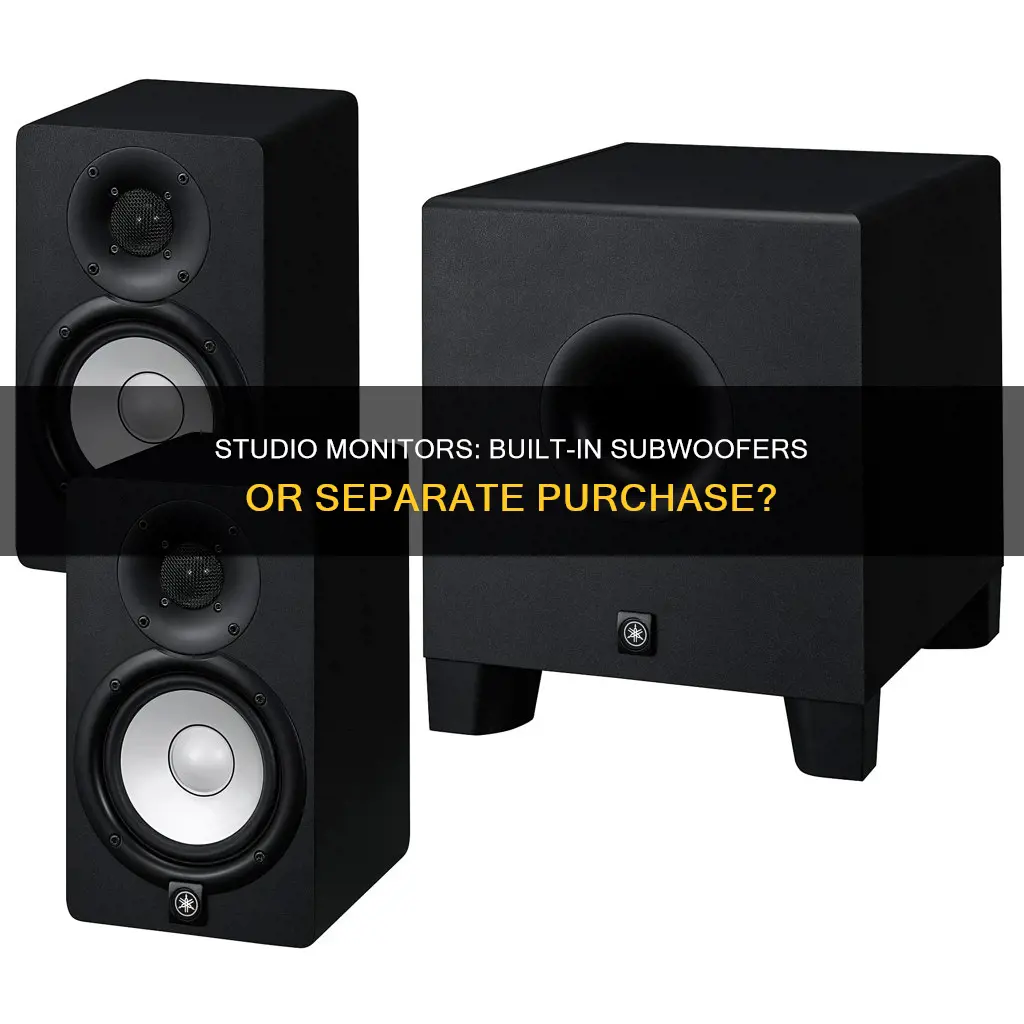
Studio monitors are speakers designed to provide an accurate representation of the audio being played. They are an essential tool for music producers and audio engineers, who require precise monitoring of low-frequency content in their mixes. While regular studio monitors can reproduce some bass frequencies, a subwoofer is designed to handle the extreme low end of the frequency spectrum, typically in the range of 20 to 200 Hz. The addition of a subwoofer to a studio setup is a common question for engineers and producers, who want to know if it will improve their ability to mix low-end frequencies.
| Characteristics | Values |
|---|---|
| Purpose of a subwoofer | To reveal the lower spectrum of frequencies so that you can make educated mixing and EQ decisions |
| Why you might need a subwoofer | To get the low end of your tracks right; to improve accuracy in bass response; to increase headroom; to get a more precise mix |
| Subwoofer types | Passive and active subs; ported and sealed enclosures; different driver sizes and materials |
| Passive subs | Require an external amplifier to power the driver |
| Active subs | Have a built-in amplifier |
| Ported enclosures | Have a vent or port that allows air to escape, providing a louder, more boomy bass response |
| Sealed enclosures | Are airtight, providing a tighter, more controlled bass response |
| Driver size | Larger drivers provide more volume |
| Driver material | Smaller drivers provide more precision |
| Subwoofers and room size | You need quite a bit of space to get the most out of a sub |
What You'll Learn

Benefits of using a subwoofer
Studio monitors can have subwoofers built in, but it is more common to have a separate subwoofer unit. Adding a subwoofer to your studio setup can be a great choice, offering a range of benefits.
Accurate Low-End Monitoring
A subwoofer can help you get the low end of your music just right. It gives you the ability to feel the power of the bass without it overwhelming the entire mix. This is especially useful for producers of electronic music, allowing for accurate monitoring of the low end.
Tactile Response
The physical feeling of the bass in your room can provide valuable feedback. You can perceive how the bass is interacting with the rest of your mix and make adjustments accordingly.
Identify Masking Issues
If the bass is too loud and masks other elements in different frequency ranges, a subwoofer can help you identify this issue. Conversely, if the bass is too quiet, you can turn it up to ensure it hits harder.
Reveal Lower Spectrum of Frequencies
Subwoofers can reveal the lower spectrum of frequencies, allowing you to make educated mixing and EQ decisions. Many instruments, such as the electric bass, grand piano, or larger drums, go lower than a typical two-way near-field monitor can register.
Improve Speaker Performance
By handling the bass frequencies, a subwoofer takes the load off your other speakers. This allows them to focus on mid-bass and midrange frequencies, improving their overall performance and clarity.
Enhanced Listening Experience
A subwoofer can elevate your listening experience, adding depth, clarity, and immersion to your music. You'll be able to feel and hear the lowest notes from instruments like the pipe organ, kick drum, or bass guitar.
Accurate Reproduction of Notes
A subwoofer accurately reproduces every note in the low-frequency spectrum, delivering bass notes exactly as the artist intended.
Seamless Blending with Full-Range Speakers
A well-calibrated subwoofer should blend seamlessly with your full-range speakers, acting as a natural extension of their low-end response.
Unleash the Potential of Smaller Speakers
By taking on the low frequencies, a subwoofer allows smaller speakers to perform to their full potential. They can reproduce sound in a more comfortable frequency range, resulting in improved sound quality.
Reduce Distortion
Subwoofers reduce distortion by lessening the acoustic demands on your other speakers. Smaller speakers often struggle to reproduce low-frequency bass accurately, leading to distortion, especially at higher volumes.
Placement Flexibility
With a subwoofer handling the bass, you have more flexibility in placing your other speakers. You won't need to worry as much about finding the perfect spot that balances bass output, and you can focus more on stereo imaging and overall sound quality.
Governments' Internet Surveillance: Privacy and Security Concerns
You may want to see also

Pros and cons of adding a subwoofer
Studio monitors can be used with or without subwoofers. While some people swear by using subwoofers, others think they are unnecessary. Here are some pros and cons of adding a subwoofer to your studio setup.
Pros
- Subwoofers can help you to identify masking issues in your music. You might realise the low end is too loud if the chest-rattling feeling is so strong that it masks other elements in different frequency ranges.
- Subwoofers can help you to get an idea of how the bass end of your music will sound.
- Subwoofers can help to improve the definition of sounds in the lower frequencies.
- Subwoofers can help to improve the soundstage of your monitors, meaning that sounds will appear to come from different areas instead of all seeming to come from the same place.
- Subwoofers can help you to clear up any muddiness and assist you in creating a clearer low end.
- If you are creating music that will be played in a club/concert-type environment with extreme low-end reinforcement, a subwoofer can help you to know what is happening in the sub-frequencies.
- Subwoofers can help with surround sound monitoring for the LFE channel.
- If calibrated correctly, a subwoofer can create an immersive and accurate mixing environment.
- Subwoofers can help with higher SPL levels while tracking instruments in a control room.
Cons
- Subwoofers can cause your speakers to become less accurate overall.
- Subwoofers can be a distraction in the studio.
- Subwoofers need a lot of space for proper control.
- Subwoofers can cause standing waves and phase cancellation issues.
- Subwoofers might not work in a small studio.
- Subwoofers might require acoustic treatment to work properly.
LCD Monitor Overheating: Why It's Hot and How to Fix It
You may want to see also

Calibrating your subwoofer
Understand the Benefits of Calibration:
Before diving into the technical aspects, it's important to grasp why calibration is crucial. Calibration ensures that your subwoofer works seamlessly with your studio monitors, creating a cohesive listening experience. It helps you make informed decisions about your mix, ensuring the low-end sits right in your tracks without overwhelming the other frequencies.
Prepare Your Equipment:
You'll need an audio interface, an SPL meter (physical or app-based), and your studio monitors and subwoofer. Connect your speakers to the audio interface and set it to unity gain. Turn down the volume of each speaker to its lowest setting.
Calibrate Your Studio Monitors:
Play pink noise through your system. Start by adjusting the level of your left studio monitor until it reaches 82 dB SPL on the SPL meter. Repeat this process for the right studio monitor. When both monitors are combined, your SPL meter should read 85 dB SPL. Fine-tune their positions to balance the level of both speakers in your mix.
Calibrate Your Subwoofer:
Turn off the studio monitors and turn on your subwoofer. Play pink noise through the subwoofer and set its level 3 dB below the level of your studio monitors (e.g., if monitors are at 82 dB SPL, set the sub to 79 dB SPL). Turn the monitors back on, play music, and adjust the sub's position as needed. Experiment with the polarity switch, choosing the setting that gives you the loudest bass response to avoid phase cancellation.
Fine-Tune with Crossover Frequency:
If your subwoofer has a crossover frequency setting, experiment with different settings until you achieve the smoothest response from your system. The goal is to make the subwoofer feel like a natural low-end extension of your main speakers.
Address Room Acoustics:
Consider the size and shape of your room. Smaller rooms with parallel walls can create standing waves that affect your ability to accurately perceive bass content. Treat your room acoustically if needed—bass traps in corners can help reduce low-end buildup.
Final Adjustments:
Play a variety of music through your system and make any necessary fine adjustments to the subwoofer's position and settings. Remember that the extra low-end frequencies from the subwoofer may interact with your room acoustics in new ways. Experiment with different positions for the subwoofer or your listening position to optimize your mixing environment.
Unlocking 144Hz: Maximizing Your ASUS FHD Monitor
You may want to see also

Subwoofer placement
When it comes to subwoofer placement, there are several factors and techniques to consider for optimal sound quality.
Firstly, it is recommended to maintain a distance of at least one foot between the subwoofer and any walls. Placing the subwoofer directly in a corner or against a wall should be avoided, as this can create an acoustic amplifier that boosts the bass and results in a boomy sound. If placement along a wall is unavoidable, pull the subwoofer 12 to 18 inches away to minimise bass buildup.
The "Rule of Thirds" suggests that placing the subwoofer about a third of the way from the wall into the room will yield the most even bass response. If this is impractical, an alternative is to position it one-fifth of the way into the room.
To improve your system's overall performance, align your subwoofer on the same vertical plane as your speakers. This minimises timing delays, eliminating acoustic issues like phase cancellation and enhancing imaging, localisation, and timing accuracy.
Another technique for optimising subwoofer placement is the "Subwoofer Crawl." Place the subwoofer at ear level in your desired listening spot, then play a bass-heavy track and start crawling around the room. Listen for areas where the bass sounds weak, uneven, or unbalanced, and mark the spots with the smoothest and most consistent bass. Adjust the subwoofer's position accordingly.
Additionally, consider the room's dimensions, surfaces, and furniture, as these factors influence sound reflection and resonance. Bass frequencies, in particular, are sensitive to room geometry and surfaces.
Remember, subwoofer placement often involves compromise, balancing optimal sound quality with practical considerations such as décor, floor space, and foot traffic.
Mounting an LCD Monitor: A Step-by-Step Guide
You may want to see also

Acoustic treatment
Common Acoustic Problems
There are several common acoustic problems that you’re likely to face:
- Comb filtering: When a direct sound is combined with its reflection, notches are introduced to the frequency response of the resulting sound.
- Flutter echo: When a sound reflects back and forth between untreated parallel walls, your ears will perceive these reflections as an echo.
- Room modes, standing waves, nodes and anti-nodes: Certain spots in your room will be more resonant within specific frequency ranges than others; these resonances are referred to as room modes.
- Excessive decay time: A room that is too 'live' can interfere with your perception of sound.
Types of Acoustic Treatment
There are several types of acoustic treatment:
- Absorption: Absorbers convert sound energy into heat. Dense, porous materials work well as absorbers; sound enters through the pores, gets trapped inside, and is then converted into heat. Porous absorbers are great for absorbing high frequencies, while panel and volume absorbers are more suited for low frequencies.
- Reflection/Diffusion: When a sound comes in contact with a reflective material, its energy is redirected. Hard, organic materials like wood do a good job of reflecting sound. Reflectors also tend to have jagged designs to diffuse the energy of sound waves.
- Decoupling and coupling: Decoupling involves reducing the amplitude of vibrations that pass from your floor to your speakers using damping pads or feet. Coupling, on the other hand, joins your speakers to your floor using speaker spikes and is used for dense floors made of materials like concrete.
Critical Treatment Zones
There are four main areas in your studio that will benefit from acoustic treatment:
- Ceiling above your desk and the walls to the left and right: Use absorbers to create a clear distinction between the direct sound generated by your speakers and the early reflections created by your room.
- Corners of your room: Place bass traps in the corners to convert low-end energy into heat.
- Parallel walls to the rear of your room: Install reflectors/diffusors to scatter the sound and prevent flutter echo.
- Back wall of your studio: Use thick hybrid acoustic treatment to reduce the adverse effects of standing waves and flutter echo.
Optimising Your Studio's Acoustics
Once you've applied acoustic treatment, use room analysis software to refine your setup. Room EQ Wizard (REW) is a free software that includes a room simulator and a real-time analyser. You can also use software like Sonarworks' Reference 4 to remove unwanted coloration from your studio speakers.
Black foam acoustic panels and egg cartons are ineffective for mid to low-end frequency absorption because they are not thick or dense enough. Moving blankets can help treat the mid-range but won't do much for low-end frequencies.
Building Your Own Acoustic Panels
You can save money by building your own acoustic panels using materials like Rockwool or Owens Corning 703. These materials are available in bulk at Home Depot.
Monitoring Bandwidth Usage: DD-WRT Router Guide
You may want to see also
Frequently asked questions
Studio monitors do not typically have subwoofers built in. However, subwoofers can be purchased separately and added to your studio setup.
Subwoofers can improve the accuracy of your bass response, increase headroom, and create a more precise mix. They can also help you feel the bass in your music, providing a physical element that enhances the listening experience.
When choosing a subwoofer, consider the size and acoustics of your room, the genre of music you produce, and the compatibility with your existing studio monitors. It's important to ensure your room has adequate acoustic treatment to avoid issues with standing waves and phase cancellation.
To set up a subwoofer, connect the left and right monitor outputs from your interface to the subwoofer, and then connect the subwoofer's outputs to your studio monitors. For calibration, adjust the subwoofer's level, crossover frequency, and phase to match your studio monitors. Proper placement of the subwoofer in the room is also crucial to achieving a flat frequency response.







